
Emergency Food

 Food in Emergency
Food in Emergency
When a disaster occurs, you should expect relief in no less than 3 days - that means at least 3 days of keeping your family fed. You will probably have no refrigeration, electricity, or gas so both traditional cooling and cooking are not available. Storing high-energy, non-perishable, no-preparation food is necessary for short-term aid. If your plans call for long-term survival, you will need to store a much larger supply of emergency food - probably not quite THIS much food, unless you're a big eater!
Stress will be very high after a crisis, so be mentally ready for it. Stress, extra physical labor, and lack of sleep will also take its toll on your body so high energy food is important. Even "empty calorie" food such as candy and other sugar-rich items are ok in these situations. As long as you have water you will probably live without food for the 3 days until help arrives, but ensuring adequate nutrition will make the challenge more endurable. Psychologically, eating will boost morale and relieve stress.
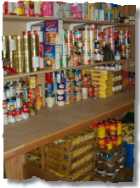 You already have some amount of food when disaster hits. Your pantry may have enough food in it right now to last a week or more. Do an inventory and see how many days of food you have. Canned food and dried food will last weeks and months. Fresh food and the food in your fridge and freezer will go bad quickly once the electricity is out. Dry food will be ruined if your house is flooded and all your food may be gone if you are hit by a tornado or hurricane.
You already have some amount of food when disaster hits. Your pantry may have enough food in it right now to last a week or more. Do an inventory and see how many days of food you have. Canned food and dried food will last weeks and months. Fresh food and the food in your fridge and freezer will go bad quickly once the electricity is out. Dry food will be ruined if your house is flooded and all your food may be gone if you are hit by a tornado or hurricane.
Set aside a specific part of your house for emergency storage. Keep your emergency water supply and food supply in the same area. A corner of your basement is an ideal location for your storage. It is cool, dark, undisturbed, and has the highest chance of surviving everything but floods. Make sure all food supplies are sealed and packed in plastic tubs to prevent mice damage.
Put heavy items, like water, down low and light weight items on higher shelves. Label everything with expiration dates and make a list of what expires next so it is easier to use and replace items.
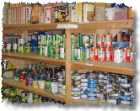 Types of Emergency Food
Types of Emergency Food
The perfect food for emergencies would be a single pill that contains all the calories and nutrition of a full meal. Until that is invented, there are some smart choices to make. The emphasis is on reduced weight, high calories, minimal preparation, long shelf life, and good taste.
Don't worry about any weight-loss diet in an emergency - you will burn lots of calories from extra activity, stress, and less sleep. Remember to keep up your water intact too.
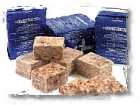 Food Bars - ready to eat bars are non-thirst provoking and provide high calories. Choose bars that exceed the recommended daily vitamin and mineral requirements - read the labels! These bars usually have a 5 year shelf life and provide about 1200 calories/day. A 3-day supply costs around $5.00 but you would want to supplement them with some other type of food because they really are a 'survival' food.
Food Bars - ready to eat bars are non-thirst provoking and provide high calories. Choose bars that exceed the recommended daily vitamin and mineral requirements - read the labels! These bars usually have a 5 year shelf life and provide about 1200 calories/day. A 3-day supply costs around $5.00 but you would want to supplement them with some other type of food because they really are a 'survival' food.
They are great for a Grab and Go kit at home or Auto kit because they are small, dense, and handle wide temperature range. A 3-day supply for a family of 4 would cost around $20.00
If you do not go with survival food bars, you may want to include some granola bars or trail bars in your supply since they are also light-weight and nutrition dense supplements to your diet.
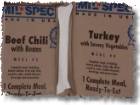 MREs (Meals Ready to Eat)
MREs (Meals Ready to Eat)
The food in these meals is sealed and then cooked. This process sterilizes the food so it has a shelf life of 5 years, and actually much longer if not subjected to extreme temperatures. MREs were first developed for the space program and then evolved into military meals and are now used by wilderness adventurers.
You can buy complete meals that include entree, side dish, dessert, drink mix, and utensils all in a pack. Or, you can stock up on individual entrees, side dishes, and desserts separately. These meals are designed to be heated, but can be eaten cold since they are already fully cooked. Place the meal pouch in boiling water to heat, or you can purchase special MRE heaters - for a price. Notice that you don't need to add water to the meals - that's a plus over dehydrated meals in the "easy to prepare" area but a minus in the "reduce weight" area.
MREs are an excellent emergency food choice, but take a deep breath before checking out the prices. Full meals cost around $5-$7 each and are typically things like barbeque pork, spaghetti, chicken ala king, and ham omelette - quite a few choices. They are compact and nutritious and would be a good addition to your Grab and Go kit. A 3-day supply for a family of 4 would cost a little under $200.
 Camping Meals - very light-weight, compact food that is reconstituted with clean, hot water. These meals are very popular with backpackers due to their light weight and good taste. They have a 2-year shelf life and cost around $4-$6 per meal, once you add in side-dish and dessert. A 3-day supply for a family of 4 would cost around $150.
Camping Meals - very light-weight, compact food that is reconstituted with clean, hot water. These meals are very popular with backpackers due to their light weight and good taste. They have a 2-year shelf life and cost around $4-$6 per meal, once you add in side-dish and dessert. A 3-day supply for a family of 4 would cost around $150.
Some companies have packages with enough dried food to feed groups of people for months or a year. These require quite an investment and would need to be consumed eventually if no emergencies occurred. If you look into these, be aware that many are survival rations meaning a day of calories may only be 1400 calories which is enough to stay alive, but not very active.
 Do It Yourself - a lower-cost alternative to specific camping products is to put together your own meals from similar pouches you can buy right in the grocery store. Knorr/Lipton has dried rice or pasta side dishes to which you can add canned tuna or chicken for very tasty, inexpensive meals. It is easy to make meals for less than $2.00 each. A 3-day supply of "do it yourself" meals for a family of 4 would easily cost less than $100. Another advantage of going this route is that you can use the food in regular meals as it reaches its expiration and replace it with fresh packages. The cost will be no more than normal meals.
Do It Yourself - a lower-cost alternative to specific camping products is to put together your own meals from similar pouches you can buy right in the grocery store. Knorr/Lipton has dried rice or pasta side dishes to which you can add canned tuna or chicken for very tasty, inexpensive meals. It is easy to make meals for less than $2.00 each. A 3-day supply of "do it yourself" meals for a family of 4 would easily cost less than $100. Another advantage of going this route is that you can use the food in regular meals as it reaches its expiration and replace it with fresh packages. The cost will be no more than normal meals.
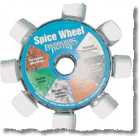 Comfort Food - be sure to include some favorite foods and snacks in your emergency food supply specifically for the effect of raising spirits. Eating somewhat bland meals for more than a couple days will become old. Make sure you stock a spice wheel so folks can add a little zip to their meals.
Comfort Food - be sure to include some favorite foods and snacks in your emergency food supply specifically for the effect of raising spirits. Eating somewhat bland meals for more than a couple days will become old. Make sure you stock a spice wheel so folks can add a little zip to their meals.
Some comfort food to consider:
- instant oatmeal
- hot chocolate mix
- instant pudding
- hard candy
- chocolate
- granola bars
- fruit bars
More Emergency Food Tips
- Try out different kinds of foods before stocking up. Make sure the taste is ok.
- Replace food before the end of its shelf life.
- Dehydrate your own food for short-term storage. Consume it every few months.
- Make your own GORP (Good Old Raisins and Peanuts) trail mix. This high-energy, high-taste snack is a great treat but do not store it more than a few months.
- Store GORP, dehydrated food, and other slightly perishable items in the freezer to extend their shelf life.
- Include a bottle of vitamin and mineral supplements in your store to ensure your body gets what it needs.
- Protein drink mixes are good supplements, if you like the taste.
- Ramen noodles - cheap, high-calorie, and light weight. Good supplement, especially for cold weather.
- Powdered milk - good calcium source and real milk won't store more than a couple hours.
- Babies - keep dry and liquid formula stored, as well as instant baby food and extra water.
- Keep a box of ZipLoc gallon bags and quart bags ready. Opened food can be stored in them as well as many other uses.
- Utensils - consider including a cook kit and portable stove with your emergency food store.
Emergency Food Product Links
|
MREs |
Freeze-dried |
Find Emergency and Disaster Info at EmergencyDude.com
